Elysai 2.0: Relational Intelligence Release
How our Relational Intelligence Engine turns customer intimacy into default relational behavior
Customer intimacy as the missing infrastructure
In today’s world, having the right features or the lowest price isn’t enough to win loyalty. What really sets lasting relationships apart is the quality of connection — the ability to build trust, communicate clearly, and show customers you truly understand them.
This is what we mean by customer intimacy. It’s not just about remembering someone’s name or what they bought last time. It’s about recognizing who they are: what they care about, how they make decisions, and what really matters to them in the moment. Humans do this naturally — we remember a friend’s preferences, we pick up on subtle shifts in tone, we adjust when we know something is important. That’s why conversations with people often feel so smooth and effortless.
But most customer-facing technology doesn’t work this way. It personalizes on the surface — showing a name, suggesting a product — without truly understanding the person behind the interaction. What’s missing is a foundation for real intimacy: systems designed to sustain trust, clarity, and respect at scale.
From concept to capability: Elysai Relational Intelligence Engine
That gap — the missing infrastructure of intimacy — is what we built Elysai 2.0 to fill. And today, it’s no longer a concept. It’s here.
We’re releasing the alpha version of the Elysai platform, available immediately. Anyone can create and deploy relational agents today, with free minutes to start and usage-based pricing as you scale. Every feature is included by default. We split access into Growth and Enterprise tiers: Growth is live now, designed for builders and teams who want to launch fast; Enterprise opens next, designed for organizations that need global reach, compliance, and deep integration.
The platform itself is built as a three-layer stack:
- Experiences — the channels and touchpoints where relational agents live and distribute, from websites to customer apps to enterprise workflows.
- Platform — the admin console to build, configure, and observe agents in real time; where you set objectives, monitor conversations, and export insights.
- Relational Intelligence Engine — the core runtime that powers every agent, built on two capabilities: Adaptive Memory and Relational Planning.
The Engine is where the breakthrough lives. Adaptive Memory continuously builds a living profile of each user, extracting not just facts but the motivations and values behind them. Relational Planning uses that profile to guide the next useful move — balancing business objectives with relational ones like clarity, autonomy, and warmth. The effect is simple but profound: agents that don’t just answer, they relate.
Adaptive Memory: knowing the person, not just the facts
There’s a difference between recall and understanding. Most systems restate what was said. Adaptive Memory goes deeper. From the same transcript, it will notice that someone seeks simplicity, tends to over-research, values sustainability, and needs one clean choice—not five “top picks.” It will remember that trade-offs named transparently reduce their anxiety. And next time, it will start there.
The Ultimate Customer360
We gave the same conversation transcripts—between users and their new therapist—to three different models. Each model was tasked with creating a user profile based on those conversations, and we then analyzed how well they performed. From this analysis, it became clear that Elysai’s profiles surpassed the others in both depth (multi-layered insight, not paraphrase) and coverage (many more relevant, non-trivial facts captured). Elysai was rated best in both. Judges’ reasoning repeatedly noted that Elysai mapped not only the explicit information shared but also the inner drivers. In practice, that meant the profile read like a human mental model: motives, constraints, styles, and likely failure modes—actionable on the very next turn.
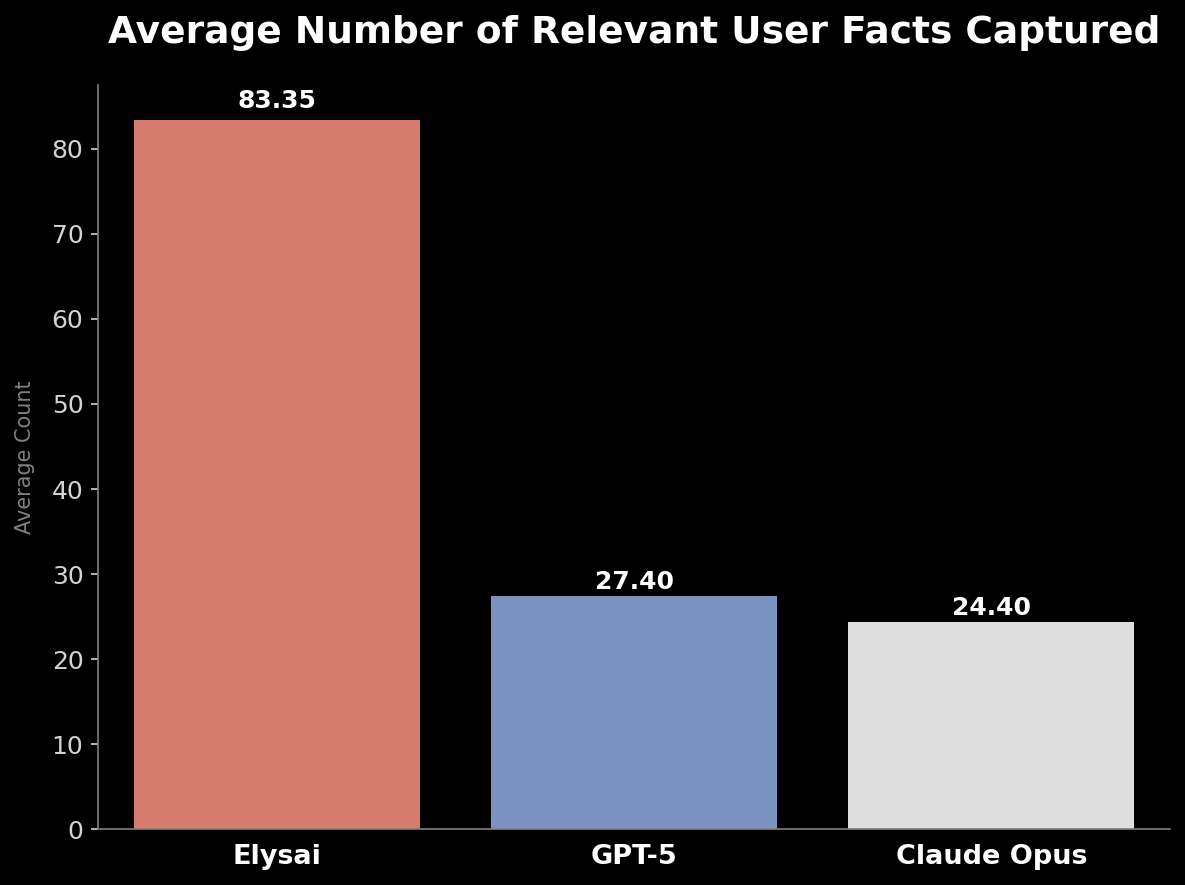
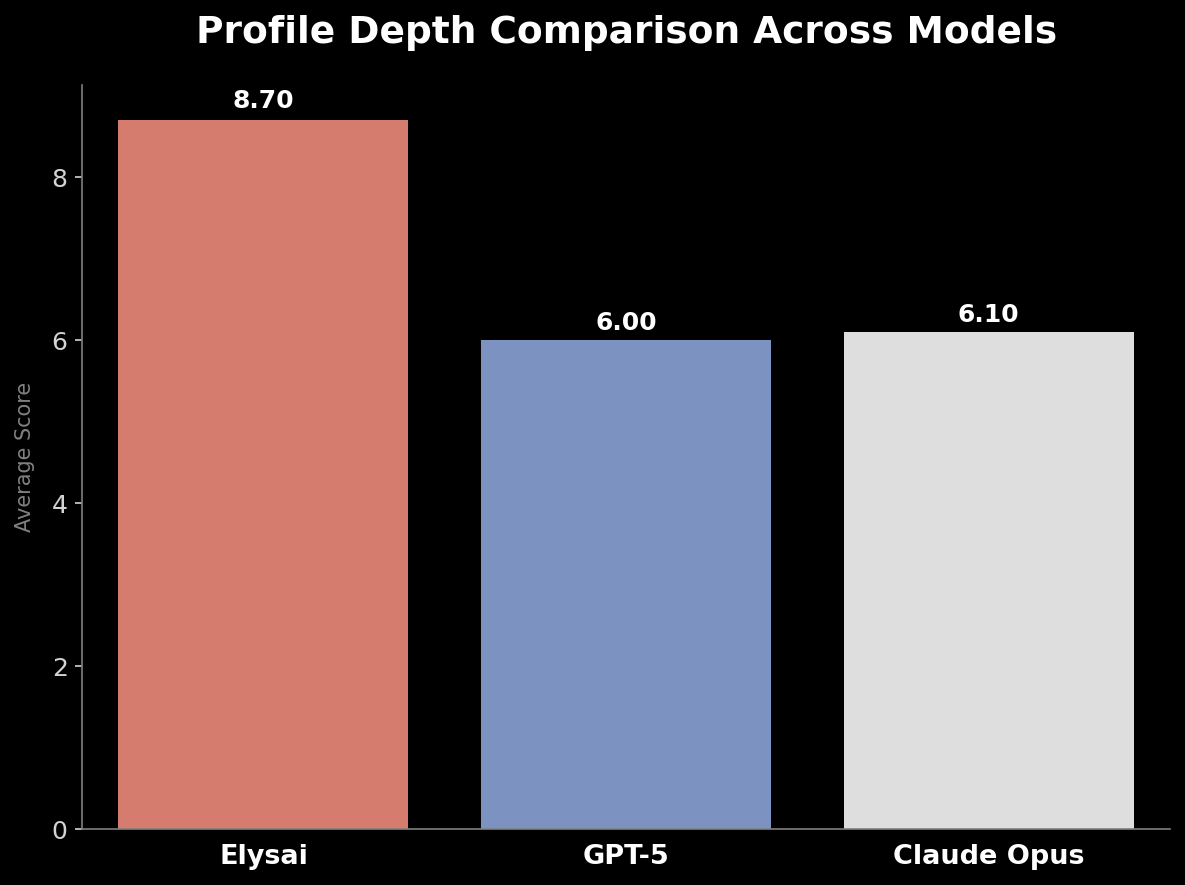
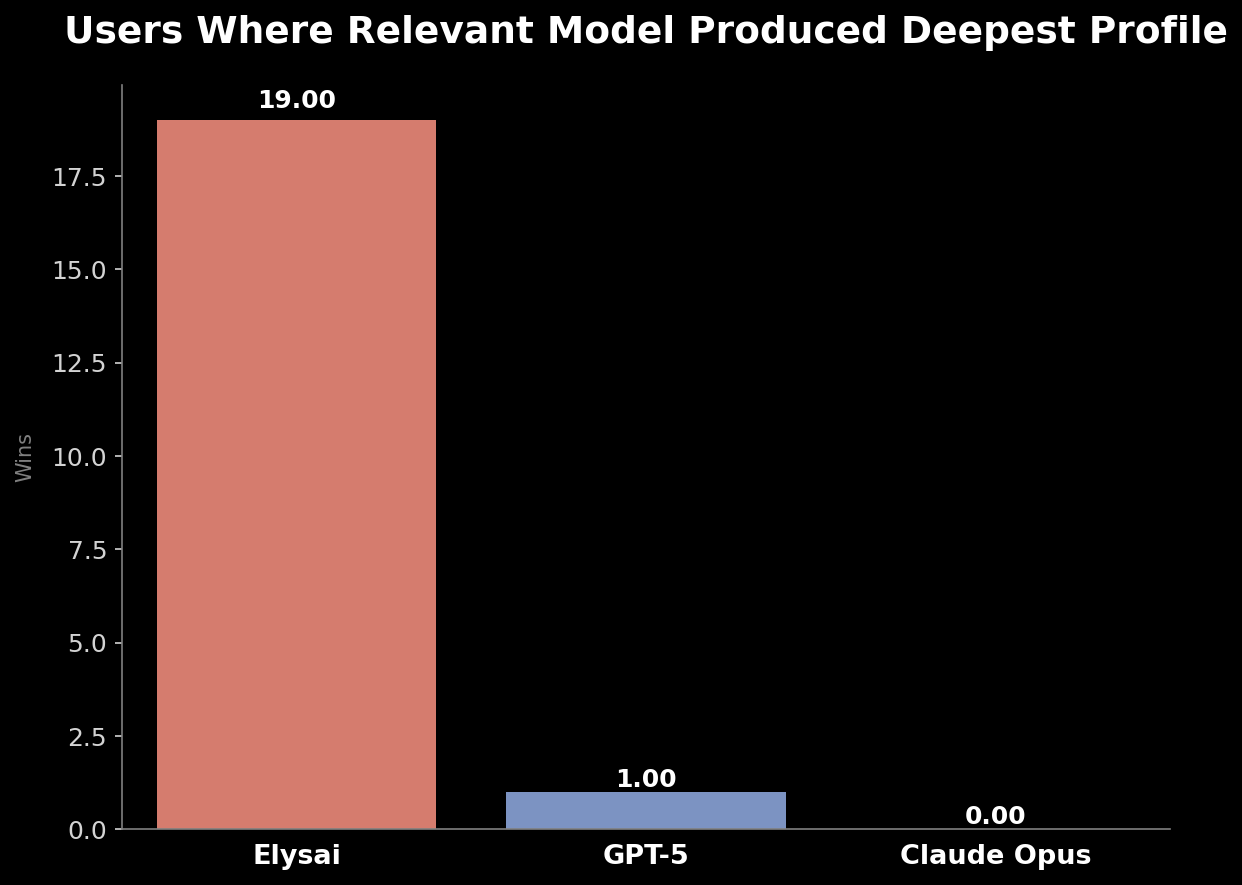
When guidance respects the why, people need fewer steps, accept clearer trade-offs, and feel seen rather than handled. That’s how “personalization” becomes intimacy.
BI note: Memory's structured outputs can be extracted. Profiles are exportable for BI (with your governance): segment by decision style, correlate values with recommendation acceptance, surface recurring friction points, and feed those insights back into product, CX, and retention.
Relational Planning: the next useful move, for this person, now
Understanding alone doesn’t move a conversation. Relational Planning does. It turns the live profile into a strategic steering that provides cognitive insight to the system that advances the task and preserves the relationship. It names why the step matters, offers real choices, and anticipates likely branches if the user pivots.
We based the comparisons on realistic conversation transcripts. Half of them were straightforward business scenarios. The other half started the same way but took an unexpected turn when the user shared difficult personal news. Each conversation was paused at a key moment, and the transcripts were given to three different models, which were asked to plan the next turns. Their plans were then compared and evaluated using impartial LLM-based judging to ensure a fair, consistent assessment across systems.
Whether in straight-line journeys (e.g., choosing sneakers) or pivot moments (e.g., the user shares hard news or priorities change), judges favoured Elysai’s plans for being more personalised, more data-grounded, and clearer about purpose and lookahead. Baseline models tended to propose generalized scripts; Elysai prepared plans that felt like partnership—acknowledge → re-anchor → proceed, without steamrolling agency.
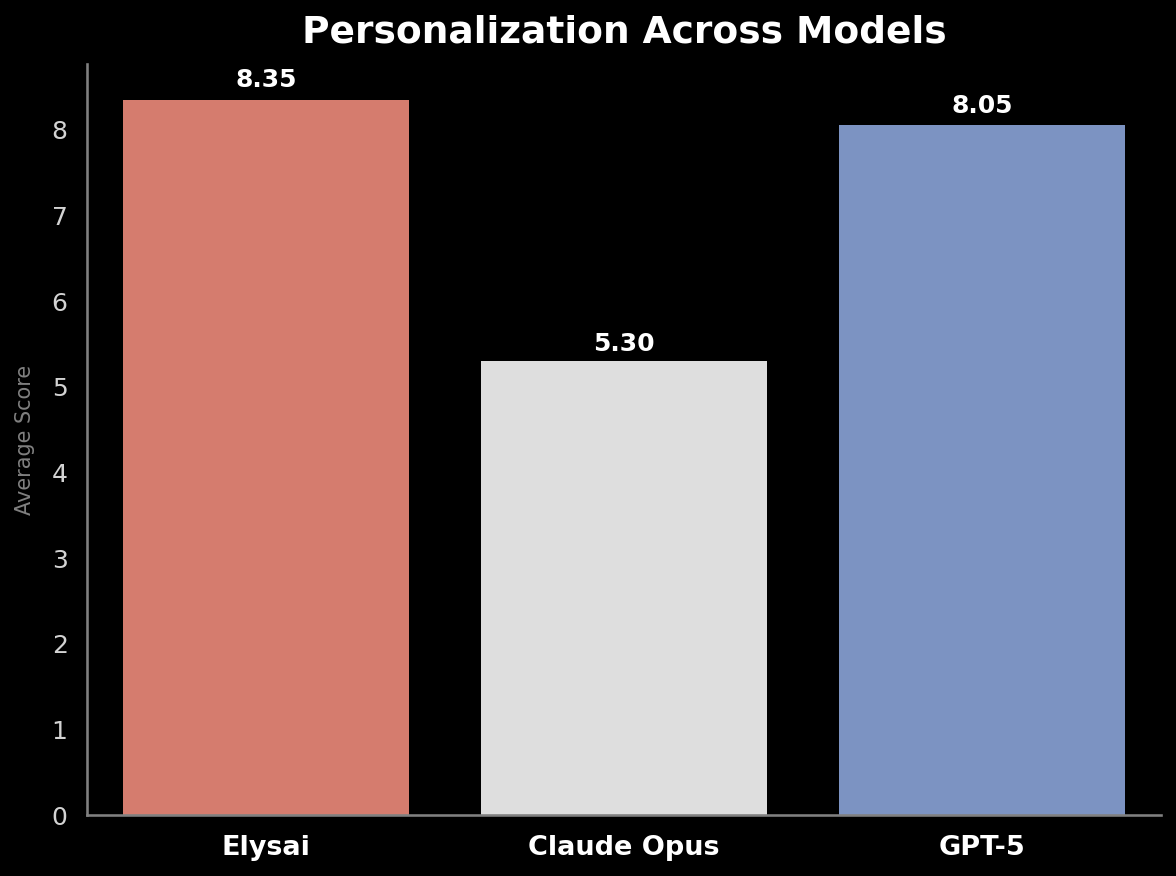
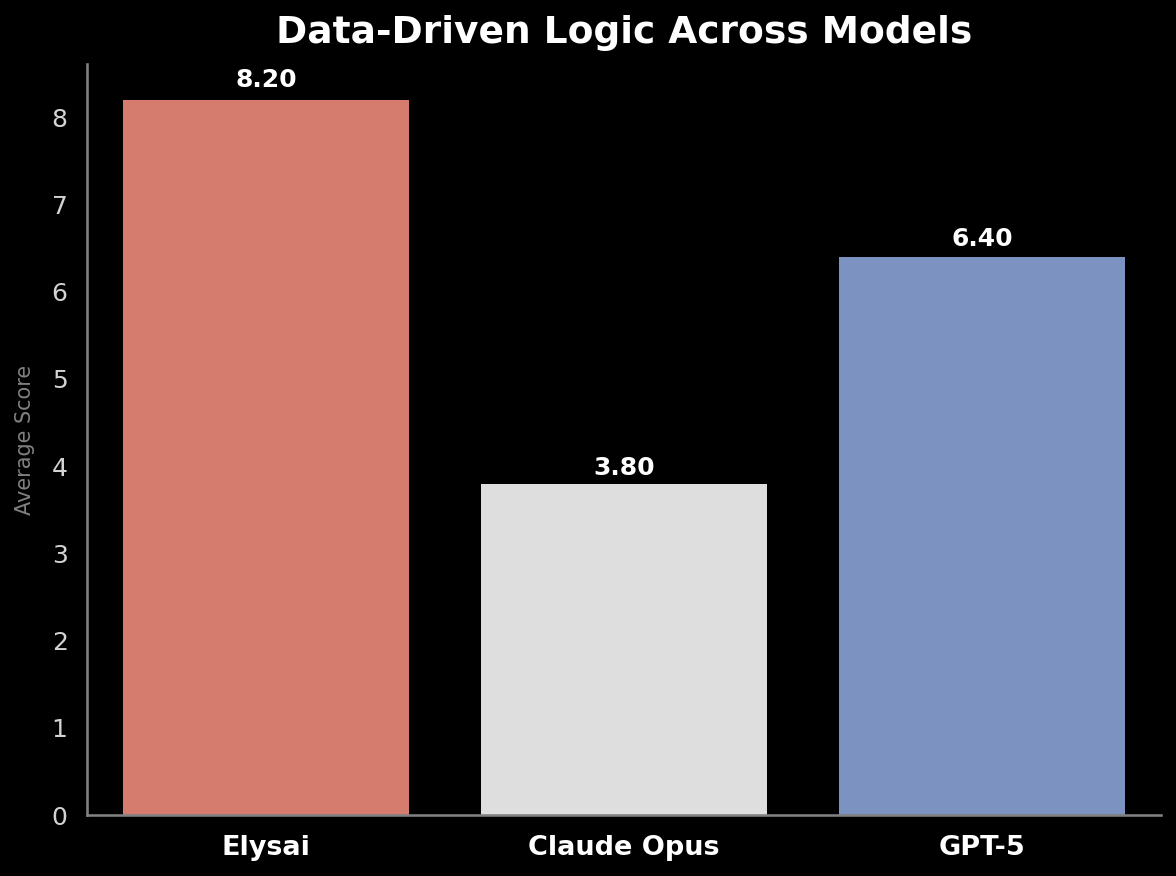
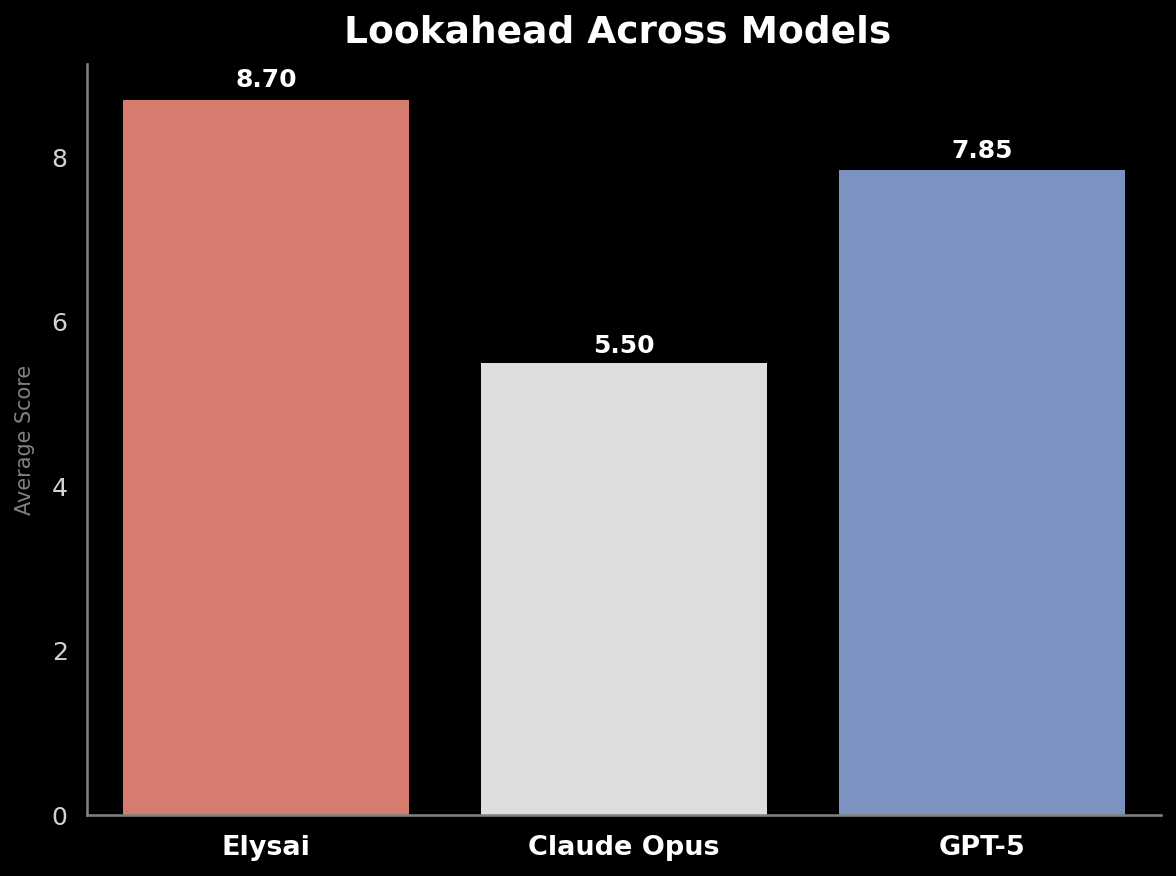
Data speaks louder than words. Our commitment to human-centric AI isn’t just a claim—it shows up where it matters most: in planning. This is the stage where it becomes clear whether the model is simply resolving tasks or taking the extra step to foster deeper connection. From a representative set of conversations, we analyzed the generated plans and the objectives they prioritized. The results tell a clear story: in 78% of cases, the model focused on improving the relationship—an area that others don’t even consider focusing on. User engagement was optimized in 69% of cases, and an aim for user improvement occurred in 50% of cases. These numbers send a message: relationship intelligence is at the core of our technology, not an afterthought.

The loop that compounds intimacy
The engine runs as a loop:
Extract → Plan → Act & Reflect → Update.
Every turn updates the profile. Every plan uses it. Every action tests it. Over time, intimacy compounds: fewer dead-ends, fewer interrogation spikes, steadier sentiment even through hard truths, and a rhythm that feels human—reciprocal, warm, purposeful.
What the benchmarks say—at a glance
- Adaptive Memory: Profiles judged deeper and broader than leading baselines, capturing several times more relevant user facts, focusing not only on the obvious information but also on implicitly stated facts, hardly noticeable for general LLM models, and consistently inferring the motives behind choices.
- Relational Planning: Plans judged more personal, more data-driven, and clearer about lookahead, especially during topic shifts, where tone, autonomy, and purpose must be rebalanced in real time.
How this lands in the real world
In service, the difference between “ticket closed” and “I trust you now” is clarity and tone—planning plus memory. In sales, transparency about trade-offs lifts acceptance, because the system knows what the person values and mirrors their pace. In healthcare and education, disclosure rises when people feel seen; the agent remembers what’s sensitive, asks one good question, and moves gently. Banking, telecom, travel—anywhere hard moments happen—benefits from the same stance: respect agency, lower cognitive load, name the trade-offs.
When conversations do that, the business metrics follow: fewer abandonments, better recommendation acceptance, steadier engagement through friction, and trust that compounds into loyalty. That’s the relationship economy in practice—and relational intelligence is how you participate in it.
Availability and the standard we’re setting
Elysai 2.0 is live today. The Relational Intelligence Engine now powers every relational agent you build on our platform. Adaptive Memory and Relational Planning are on by default; you decide the objectives, and the governance. Growth access is available immediately with free minutes to start and usage-based pricing as you scale, while Enterprise offerings will open next for organizations that need global reach and deep integration.
Soon, the Engine will also be exposed through an API, so you can bring relational intelligence into your own customer-facing agents — the same Memory and Planning, running in your stack. And Memory’s structured outputs can be extracted for BI, giving teams new ways to understand customer motivations safely and at scale.
Elysai 1.0 proved that people are willing to trust a digital human. Elysai 2.0 makes that trust the default. By weaving Adaptive Memory and Relational Planning into a single Relational Intelligence Engine, we’ve turned conversations from transactions into relationships — at scale, and by design.
Elysai 1.0 proved that people are willing to trust a digital human. Elysai 2.0 makes that trust the default. By weaving Adaptive Memory That’s the bar we’re setting: agents that know me, guide me, and never reduce me.
Because AI shouldn’t just be smart.
It should make people better.